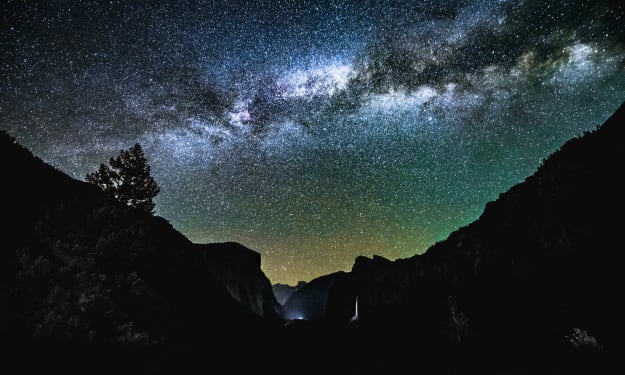Dust, Darkness and Demons
"We are made of star stuff"-Carl Sagan

Nobody can hear a scream in the vacuum of space, or so they say.
Space is cold and unforgiving, even if sound could exist in a vacuum.
There is no one in earshot to hear it. Not the way you would think, at least.
So in many ways, you are the tree that falls in the woods, but in this case, the answer desires no ponderance. You will never make a sound in space.
Death in the vacuum of space does not go unnoticed; it almost always attracts dust eaters. When humans "give up the ghost." The stardust that makes "us," "us," goes back to the universe at the time of death. Not dust like the dust you blow off of forgotten books. Actual stardust is the fabric of time and space; to be more specific, the scaps and loose threads of that fabric. Human consciousness is an upcycle of those raw primordial celestial fragments or gross misuse of resources depending on the particular mouth breather. There were initial inklings from some of the less scientific members of the science community when actual stardust was first quantified that postulated "dark" dust making excremental people possible. This theory has been exhaustively disproven, stardust is pure light, and the human part of the equation is the variable capable of flaw.
The beautiful machine you ride around is composed of about 600 US dollars worth of primary materials (back in 2022 before oxygen got outrageous in price). Though complex, intricate, and often mysterious, a pale shell compared to the heavenly ethereal spark of dust. The human body is shaped by evolution to exist in symbiotic harmony with the little piece of the universe that makes us unique and unforgettable. Early on, they were so close to this in religion but just missed it, "dust to dust," Adam made from dust and Eve from his rib and the whole concept of the souls. The forest for the trees, I guess.
Back to the dust eaters, to the ultimate destiny of the brilliant dust swirling through every fiber of your being. The simplest way to wrap your mind around it is that if you die on earth, your dust tends to reinvest in the population. "You" go back to being part of a bigger whole for a bit before "upcycling" again into another beautiful machine or at least some particles of "you" will. So some particles are lost to the universe; some ultimately get gobbled up by nearby Dust eaters lingering just outside our atmosphere. When you die in space far from the home population, you are fast food for dust eaters; they get all of you, and just like french fries, restraint is never part of the narrative.
Dust eaters are the oldest demons in our drama; they predate all of what we perceive as time. They don't have form and don't follow any of the same rules we do, which, considering they live in the darkness of space and are relatively invisible, makes sense. Think sharks, perfect prehistoric predators mixed with blackholes. So invisible great whites that can phase through matter and consume anything in their path, not even light can escape. To add to their ferocity, they can be mosquito small or as big as a great white, depending on their diet. And similar to sharks, they have no remorse, no moral conundrum about the vibration of a flailing fish; it just registers as food. So when the dust leaves your lifeless body in space, it emits that distressed dinner bell vibration akin to a floundering flounder.
For most of human history, they were a non-issue; we didn't know much about them or dust until we started seeing the effect of the toxic relationship humanity has always had with its beautiful, supportive home. Killing the planet at an accelerated rate was just the start of the story; the move to mass space travel, terraforming, and colonization gave us new and ruthless things to fear in the dark.
Dust eaters, as I said, are near invisible, I should explain. The first recorded data on them came from a "black box" of an overloaded colonist ship that suffered a massive hull breach in transit to IO. The vessel encountered a meteor storm and did not survive; neither did the crew or the passengers, all 10,000. But the sensors and video feed did, and when the wreckage was recovered and analyzed, there was a monumental discovery.
At first, researchers did not know what to make of it; there was a rapid depressurization of the main cabin and thousands of frozen corpses floating around the debris. What happened next was the brief, intense flashes that occurred in quick succession, moving like a wave of fire from one end of the room to the other. The flashes were brilliant but brief and seemed to localize around the bodies adrift. When researchers slowed the recordings to a crawl, a cloud of bright luminous dust seemed to escape from the deceased's chest. It appeared to glow brighter as something sucked it up; in summation, at its most concentrated bright point, it flashed like a micro supernova and then when dark. When they slowed the flash down even further, it defined the "shape" of the sucker right before the instant of light expired. Then, for a fraction of a microsecond, after the blinding flash illustrated the invisible predator's shapeless scale, it illuminated their neural network with a little lightning storm, speculation but sound in theory. Almost imperceivable if it hadn't been a feeding frenzy of thousands.
This first data lead to the discovery of dust and Dust eaters. It also leads to the discovery of how to "see them" and stardust. Gamma rays through a gamma telescope emit beautiful auras of color when pointed to celestial phenomena like white dwarfs, cluster galaxies, remnants of supernovas, and black holes. After that, it was just a matter of scaling down the technology.
This detection method went from novel to vital almost immediately. With earth dying and the mass exodus to the stars, colony ship calamities turned space into an all-you-can-eat buffet for creatures that had lived on moderate scraps. As their food supply expanded, they began to evolve; they began to cause the catastrophes that led to the feast. And as the earth's atmosphere became less stable, their hunger led to their boldness to beach themselves for sea lions (us). They didn't wait for death; they became so ravenous they just ate the wrapper with the burger.
The corporate governments mobilized to make weapons of budding technology whose original intent was to shield against gamma radiation for space travel and defense. However, the new projectiles could disperse the gamma radiation by utilizing nano polymers and Iron (Fe). Unfortunately, this new slingshot technology did not solve the problem but presented a pervasive persuasion to the eaters to find a different snack.
So back to warding off invisible demons after your soul with Iron and magical lenses that grant extraordinary sight...
About the Creator
Phillip Johnson
Quietly questioning the quips,querries,quandries and quagmires while questing for quail.






Comments
There are no comments for this story
Be the first to respond and start the conversation.